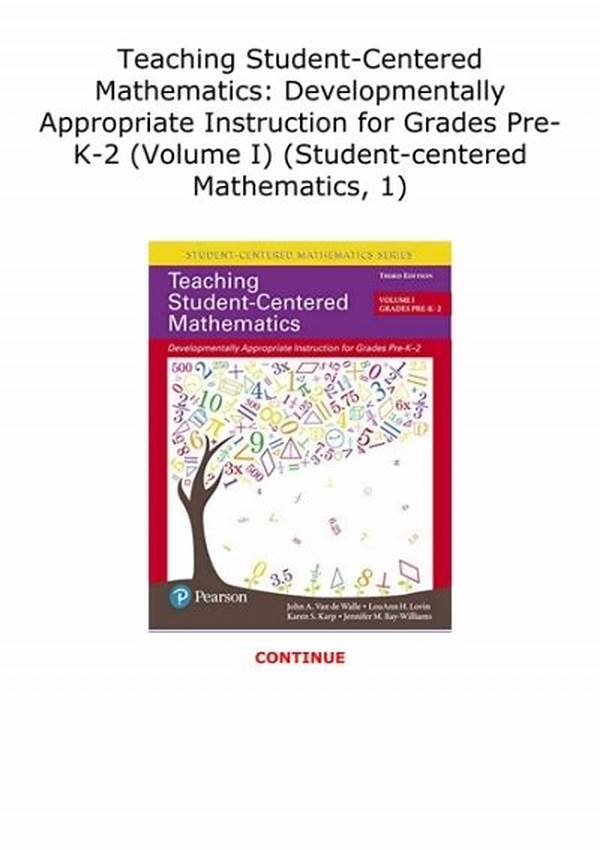In recent years, educational paradigms have shifted towards approaches that place students at the heart of the educational process. One such approach is the student-centered math instruction design, which prioritizes the unique needs, challenges, and interests of each learner. This pedagogical method emphasizes active student participation, fostering a deeper understanding of mathematical concepts.
Read Now : Math Lessons For Diverse Learners
Key Principles of Student-Centered Math Instruction Design
Student-centered math instruction design is characterized by its focus on individualized learning paths. This approach recognizes that each student brings unique strengths and weaknesses to the classroom. As such, instruction is tailored to meet these diverse needs, allowing students to progress at their own pace. The environment allows for cooperative learning, encouraging students to collaborate with peers, share ideas, and learn from different perspectives. Furthermore, technology plays a vital role, offering interactive tools that make mathematical concepts more accessible and engaging. By leveraging technology, educators can create a dynamic classroom atmosphere that inspires curiosity and creativity.
Another fundamental principle of student-centered math instruction design is its commitment to real-world application. Mathematics is not taught in a vacuum; instead, it is connected with real-life situations that students can relate to and understand. Teachers often use project-based learning or problem-solving activities that mirror real-world challenges. This application of math to everyday problems not only enhances engagement but also helps in solidifying students’ understanding of abstract concepts. Through such experiential learning, students are better prepared to apply their knowledge outside the classroom environment.
Assessment within the student-centered math instruction design is also innovative and flexible. Instead of traditional assessments that solely focus on rote memorization and procedural skills, these classrooms implement formative assessments. These assessments provide timely and constructive feedback, enabling students to reflect on their learning progress. Students are encouraged to set personal learning goals and take ownership of their educational journey. By doing so, the focus shifts from competition to mastering content according to individual capabilities.
Benefits of Student-Centered Math Instruction Design
1. Personalized Learning: Student-centered math instruction design facilitates personalized learning experiences, allowing students to engage with content at a level and pace that matches their individual learning needs and styles.
2. Enhancing Critical Thinking: This approach is pivotal in developing students’ critical thinking and problem-solving skills, as it encourages them to understand concepts deeply rather than memorizing them superficially.
3. Increased Engagement: By incorporating interactive and cooperative learning strategies, student-centered math instruction design effectively enhances student engagement and motivation.
4. Skill Application: Students are often provided with scenarios that apply math in real-life contexts, which reinforces the idea that the skills acquired in class are valuable and applicable beyond academic settings.
5. Holistic Assessment: Student-centered math instruction design prioritizes holistic assessment methods that focus on providing comprehensive feedback and fostering self-assessment skills, moving away from solely standardized testing models.
Strategies for Effective Implementation
Implementing student-centered math instruction design requires careful planning and commitment from educators. Firstly, teachers need to create an inclusive classroom environment where all students feel valued and respected. This involves recognizing and addressing diverse learning styles and ensuring that all voices are heard. Moreover, teachers should continually adapt their instructional methods based on student feedback and performance data, fostering a culture of continuous improvement.
Read Now : Innovative Methods For Weekend Instruction
Instructors are encouraged to integrate various technological tools that align with student-centered methodologies. These might include online platforms, educational apps, and interactive whiteboards, all of which can make learning more engaging and accessible. Additionally, professional development for teachers is paramount in equipping them with the skills and knowledge necessary to implement these innovative practices effectively.
Implementing Student-Centered Math Instruction Design: A Case Study
A prominent example of effective student-centered math instruction design was observed in a middle school in California. Teachers there shifted from traditional textbook-driven lessons to a more dynamic curriculum. They incorporated project-based learning, where students were tasked with designing their own mini businesses. This required them to apply various mathematical concepts such as calculations of profit margins, budgeting, and data analysis through the use of spreadsheets. The real-life application of math in a business context equipped students with valuable lifelong skills and spurred interest in entrepreneurial ventures.
Furthermore, the use of technology in this case study proved instrumental. Students utilized math-oriented software to visualize complex equations, making abstract concepts tangible. The teachers also provided regular feedback through digital platforms, enabling continuous learning progression and fostering a more engaged classroom dynamic.
Challenges of Student-Centered Math Instruction Design
While student-centered math instruction design offers numerous benefits, it is not without challenges. One significant hurdle is the time required for teachers to design personalized learning activities and assessments. The preparation involved can be extensive, requiring creativity and constant adaptation to meet students’ evolving needs. Additionally, ensuring equal participation from all students in activities may present challenges, particularly for those who are less inclined to express themselves in group settings.
Teachers must also navigate the diverse technological landscape, selecting appropriate tools that effectively support learning without becoming distractions. Moreover, schools must allocate resources and professional development opportunities for educators to remain updated with current educational technologies and practices. Despite these challenges, the merits of student-centered math instruction design continue to make it a compelling choice for modern educators.
Conclusion: Embracing Student-Centered Math Instruction Design
In summary, the student-centered math instruction design offers a transformative approach to math education by placing students at the helm of their learning journeys. By fostering a collaborative and inclusive classroom environment, emphasizing real-world applications, and implementing flexible assessment methods, this design empowers students to truly grasp mathematical concepts. The integration of technology further amplifies these benefits by providing interactive and engaging learning experiences. As educators continue to embrace this innovative approach, they can expect to cultivate a generation of learners who are not only proficient in mathematics but also equipped with critical thinking and problem-solving skills essential for future success.
